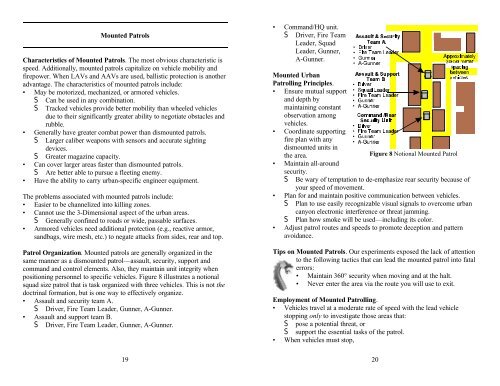Urban Patrolling Tactics, Techniques and Procedures - Defense ...
Urban Patrolling Tactics, Techniques and Procedures - Defense ...
Urban Patrolling Tactics, Techniques and Procedures - Defense ...
Create successful ePaper yourself
Turn your PDF publications into a flip-book with our unique Google optimized e-Paper software.
Mounted Patrols<br />
Characteristics of Mounted Patrols. The most obvious characteristic is<br />
speed. Additionally, mounted patrols capitalize on vehicle mobility <strong>and</strong><br />
firepower. When LAVs <strong>and</strong> AAVs are used, ballistic protection is another<br />
advantage. The characteristics of mounted patrols include:<br />
• May be motorized, mechanized, or armored vehicles.<br />
S Can be used in any combination.<br />
S Tracked vehicles provide better mobility than wheeled vehicles<br />
due to their significantly greater ability to negotiate obstacles <strong>and</strong><br />
rubble.<br />
• Generally have greater combat power than dismounted patrols.<br />
S Larger caliber weapons with sensors <strong>and</strong> accurate sighting<br />
devices.<br />
S Greater magazine capacity.<br />
• Can cover larger areas faster than dismounted patrols.<br />
S Are better able to pursue a fleeting enemy.<br />
• Have the ability to carry urban-specific engineer equipment.<br />
The problems associated with mounted patrols include:<br />
• Easier to be channelized into killing zones.<br />
• Cannot use the 3-Dimensional aspect of the urban areas.<br />
S Generally confined to roads or wide, passable surfaces.<br />
• Armored vehicles need additional protection (e.g., reactive armor,<br />
s<strong>and</strong>bags, wire mesh, etc.) to negate attacks from sides, rear <strong>and</strong> top.<br />
Patrol Organization. Mounted patrols are generally organized in the<br />
same manner as a dismounted patrol—assault, security, support <strong>and</strong><br />
comm<strong>and</strong> <strong>and</strong> control elements. Also, they maintain unit integrity when<br />
positioning personnel to specific vehicles. Figure 8 illustrates a notional<br />
squad size patrol that is task organized with three vehicles. This is not the<br />
doctrinal formation, but is one way to effectively organize.<br />
• Assault <strong>and</strong> security team A.<br />
S Driver, Fire Team Leader, Gunner, A-Gunner.<br />
• Assault <strong>and</strong> support team B.<br />
S Driver, Fire Team Leader, Gunner, A-Gunner.<br />
19<br />
• Comm<strong>and</strong>/HQ unit.<br />
S Driver, Fire Team<br />
Leader, Squad<br />
Leader, Gunner,<br />
A-Gunner.<br />
Mounted <strong>Urban</strong><br />
<strong>Patrolling</strong> Principles.<br />
• Ensure mutual support<br />
<strong>and</strong> depth by<br />
maintaining constant<br />
observation among<br />
vehicles.<br />
• Coordinate supporting<br />
fire plan with any<br />
dismounted units in<br />
the area.<br />
Figure 8 Notional Mounted Patrol<br />
• Maintain all-around<br />
security.<br />
S Be wary of temptation to de-emphasize rear security because of<br />
your speed of movement.<br />
• Plan for <strong>and</strong> maintain positive communication between vehicles.<br />
S Plan to use easily recognizable visual signals to overcome urban<br />
canyon electronic interference or threat jamming.<br />
S Plan how smoke will be used—including its color.<br />
• Adjust patrol routes <strong>and</strong> speeds to promote deception <strong>and</strong> pattern<br />
avoidance.<br />
Tips on Mounted Patrols. Our experiments exposed the lack of attention<br />
c<br />
to the following tactics that can lead the mounted patrol into fatal<br />
errors:<br />
• Maintain 360° security when moving <strong>and</strong> at the halt.<br />
• Never enter the area via the route you will use to exit.<br />
Employment of Mounted <strong>Patrolling</strong>.<br />
• Vehicles travel at a moderate rate of speed with the lead vehicle<br />
stopping only to investigate those areas that:<br />
S pose a potential threat, or<br />
S support the essential tasks of the patrol.<br />
• When vehicles must stop,<br />
20

















